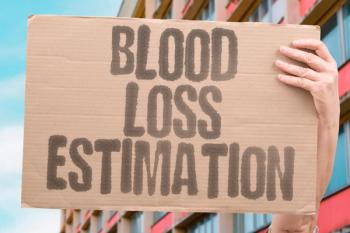
A practical approach to low-molecular-weight heparin in gynecologic surgery
Thromboembolic complications are common after gynecologic surgery. All too often, DVT is discovered on autopsy. The authors offer a practical evidence-based perspective on prophylaxis with external pneumatic compression and LMWH.
LMWH IN GYNECOLOGIC SURGERY
A practical approach to using low-molecular-weight heparin in gynecologic surgery patients
By Louis A. Dainty, MD, G. Larry Maxwell, MD, and Daniel L. Clarke-Pearson, MD
Thromboembolic complications are common after gynecologic cancer surgery. All too often, however, DVT is discovered on autopsy. The authors offer a practical evidence-based perspective on prophylaxis with external pneumatic compression and LMWH.
Deep venous thrombosis (DVT) and pulmonary embolism (PE) are major complications of surgery for gynecologic cancer that result in significant morbidity and mortality. Approximately 260,000 cases of clinically diagnosed DVT occur every year, resulting in 100,000 recognized deaths directly attributed to PE.1,2 The incidence of DVT in gynecologic surgery varies widely, depending on each patient's individual risk factors.
Studies using the most sensitive detection methods suggest that about 14% of patients undergoing gynecologic surgery for benign indications develop thromboembolism.3 DVT has been observed in 38% of patients after surgery for gynecologic cancer.4 PE accounts for 3% of all deaths following gynecologic surgery and is a leading cause of postoperative death in the highest-risk patients with uterine, ovarian, or cervical carcinoma.5,6 Thirty percent of patients who have a perioperative thromboembolic event are also at risk for chronic postthrombotic syndrome (characterized by venous ulceration, debilitating pain, and intractable edema).7 As many as 90% of patients with venous thrombosis are found to have milder forms of disability when follow-up is extended for 2 to 5 years. The economic costs of thromboembolism are expected to rise as the prevalence of this preventable cardiovascular disease increases in the aging population.8,9
Most patients with fatal PE die within the first 30 minutes after onset of symptoms, and in 70% of cases, the diagnosis is not made until autopsy.10,11 Improved methods of DVT prevention (in contrast to surveillance or intervention) are therefore needed to minimize the acute mortality associated with embolic complications and the long-term morbidity associ- ated with postthrombotic syndrome. Less expensive methods of DVT treatment also are needed to reduce costs associated with this perioperative complication. This article reviews the use of low-molecular-weight heparin (LMWH) for prophylaxis of thromboembolism in patients undergoing gynecological surgery.
The chemistry behind LMWH
LMWH are 4,500- to 6,500-Dalton glycoproteins produced by the controlled enzymatic or chemical depolymerization of unfractionated heparin (Table 1). Binding of any pentasaccharide-containing heparin (that is, unfractionated heparin or LMWH) to antithrombin III can result in a conformational change, facilitating inactivation of factor Xa. A longer heparin moleculeunfractionated heparincontaining a saccharide chain of at least 18 units is required to effect conformational change in antithrombin III. The reduced thrombin inactivation caused by the shorter LMWH fragments, coupled with decreased platelet binding, may result in fewer bleeding-related complications in some surgical patients. Whether heparin fractions that have similar molecular weights but are produced in a different way have similar anticoagulant properties remains unclear (Figure 1).12
TABLE 1
Clinical use of FDA-approved LMWH*
LMWH's smaller size results in unique pharmacologic properties that translate into improved bioavailability. Compared to unfractionated heparin, LMWH has a much lower affinity for plasma and matrix proteins. Binding to these molecules can decrease the anticoagulant effects of the heparin, making the anticoagulant response unpredictable because of the variability in concentration of heparin-binding proteins. LMWH also has less of a propensity to bind to macrophages, which explains why it does not undergo hepatic clearance to the same degree as unfractionated heparin. As a result, LMWH has longer, more predictable, and dose-independent renal clearance. The more prolonged clearance associated with LMWH leads to a longer serum half-life and better bioavailability. Compared to unfractionated heparin, LMWH is much more bioavailable even after subcutaneous injection (30% vs. 90% to 100%).13 Because of this improved bioavailability, once-a-day dosing is possible with most formulations.
Most of the anticoagulant effects of LMWH are a result of anti-factor X properties. Because of its shortened heparin chain, LMWH has minimal effects on thrombin (Figure 1). Therefore, activated thromboplastin time (aPTT) is often not increased, so it is not necessary to do serial laboratory monitoring of aPTT levels in patients taking LMWH. Similarly, monitoring of anti-Xa activity is not of significant benefit in dosage adjustment, even though anti-Xa levels can be calculated to determine the anticoagulant effect using the "heptest."14
Although several types of LMWH are commercially available worldwide, only three formulations are currently FDA-approved for perioperative thromboprophylaxis (Table 1). In the United States, the other forms of the drug must either be used "off-label" or under a research protocol, although literature on their efficacy and safety is mounting. LMWH dosage should be adjusted according to a patient's level of risk for postoperative thromboembolism. Patients with cancer who are undergoing surgery may benefit from higher doses of LMWH, but first consider the potential risks of increased bleeding associated with this therapy.
Preventing DVT in patients undergoing gynecologic surgery
Investigators at Duke University have evaluated several ways of preventing DVT and thereby minimizing thromboembolic complications after surgery in patients with gynecologic cancer. For DVT prevention in patients undergoing advanced gynecologic surgery, unfractionated heparin is not clinically significantly better than external pneumatic compression (EPC). Unfractionated heparin can also increase the risk of transfusion, when compared to intermittent EPC.12 As a result, in many centers, EPC is the predominant prophylaxis for gynecologic surgery patients. Recently, however, attention has focused on use of LMWH for thromboembolism prophylaxis in these patients.
Efficacy of LMWH. Studies of perioperative LMWH prophylaxis in gynecologic surgery are limited and confined to the European literature. Similar rates of postoperative DVT have been reported in the five published randomized trials comparing LMWH and unfractionated LDH. In this collective group of 804 operative patients, the rate of thromboembolism was approximately 1%, with DVT diagnosed in six patients who received LDH and two who received LMWH prophylaxis (P<0.05). A recent meta-analysis of general and gynecologic surgery patients from 32 trials likewise indicated that daily LMWH administration is as effective as unfractionated LDH in DVT prophylaxis, with no difference in hemorrhagic complications. Because the anti-Xa activities of different LMWH preparations vary, however, these data should be interpreted with caution.
Complications of LMWH. Compared with unfractionated heparin, LMWH prophylaxis may be associated with fewer perioperative bleeding complications in some surgical settings. Our group recently performed a prospective, randomized clinical trial to evaluate LMWH in gynecologic surgery patients.15 We compared LMWH and EPC, which has been our standard method of postoperative prophylaxis in gynecologic surgery patients. The women in the study were older than age 40 and undergoing major abdominal or pelvic surgery for known or suspected gynecologic malignancy and received either LMWH or EPC perioperatively.
The two groups were similar in estimated blood loss and number of patients with excessive intraoperative hemorrhage (>2,000 mL blood loss). Approximately 10% of patients received perioperative blood transfusions, but the type of prophylaxis did not affect the frequency of transfusion. Incisional hematomas were infrequent and the incidence was not statistically increased in the women who received LMWH. In contrast to our prior experience with unfractionated heparin, use of LMWH was not associated with an increased risk of bleeding complications compared to EPC.16 Both LMWH and EPC appeared to be reasonable choices for prophylaxis for high-risk patients.
Major bleeding complications due to LMWH should be treated as indicated with packed red blood cells to maintain hemodynamic stability. In the event of severe bleeding, fresh frozen plasma provides more antithrombin III substrate for the LMWH but does not necessarily change its half-life or effect. Protamine, the standard reversal agent for unfractionated heparin, is not fully effective against LMWH. It can reverse the anti-IIa activity of LMWH but does not completely neutralize anti-Xa activity, which is LMWH's primary site of effect. A dose of 1 mg protamine/100 LMWH anti-Xa units reverses 90% of anti-IIa and 60% of anti-Xa activity. Both anti-IIa and anti-Xa activity may return up to 3 hours after protamine reversal, possibly due to release of additional LMWH from the subcutaneous depot.
Thrombocytopenia, a complication of heparin administration, occurs in approximately 3% of patients receiving LMWH.17 Stimulation of anti-platelet antibodies may result from heparin activation of platelets and release of Platelet Factor 4. A randomized trial comparing prophylaxis with unfractionated heparin and LMWH revealed a significantly lower incidence of thrombocytopenia associated with LMWH. The lower incidence of heparin-induced thrombocytopenia may be due to decreased LMWH binding to platelets compared to unfractionated heparin.18,19
Significant attention has been drawn to the risk of using neuraxial anesthesia (spinal or epidural) in patients receiving LMWH. In 1997, the FDA released a statement warning that spinal hematoma can occur as a complication of spinal or epidural anesthesia in patients receiving LMWH.20 Many of the cases reported to the FDA occurred within hours of catheter removal, suggesting that it may be a traumatic event in these settings. Among the reported cases, the risk appeared to be greatest in patients who were also taking nonsteroidal anti-inflammatory drugs, platelet inhibitors, or other anticoagulants. Because of the FDA concerns, manufacturers of LMWH advocate that the agents not be used concurrent with or within 12 to 24 hours of spinal or epidural anesthesia.
Quality-of-life considerations
The role of patient preference. Investigators at Duke University have also looked at the role of patient preference in women receiving EPC versus those given perioperative LMWH prophylaxis. We assumed that if the two methods had similar complication rates, differences in patient preference and compliance might be important in determining which was superior.
In our study, 211 patients undergoing major surgery for a suspected gynecologic malignancy were randomized to prophylaxis with either EPC or LMWH. The women completed surveys on thromboembolism prophylaxis before surgery and approximately 7 days after their procedure. The questionnaires explored patient preferences and reasons for dissatisfaction with prophylactic methods. Compliance with prophylaxis also was recorded twice a day during each woman's hospitalization. A patient was considered to be noncompliant if her EPC device was not functioning properly or if she was not given LMWH in a timely fashion.
Our results failed to show that patients preferred LMWH to EPC preoperatively or postoperatively.21 Previous experiences with medical monitoring equipment, EPC or injections did not contribute to the women's preferences. The two groups also did not differ in level of anxiety related to injections, eliminating that experience as a bias in our conclusions. In 78% of the women receiving LMWH and 74% of those wearing EPC, patient preference corresponded with the method actually used, indicating a high level of satisfaction.
The role of cost. If efficacy, patient complications, preference, and compliance are similar between LMWH and EPC, then cost may determine which method is superior for postoperative prevention of thromboembolism in women undergoing surgery for gynecologic cancer. To test this hypothesis, we used a decision analytic model to describe the outcomes and costs associated with EPC, unfractionated heparin, LMWH, and no prophylaxis.22
Our model was applied to three types of patients routinely seen by gynecologic oncologists: the 35-year-old woman with Stage IB cervix cancer, the 55-year-old woman with Stage IA endometrial cancer, and the 65-year-old woman with Stage IIIC ovarian cancer. Outcome probabilities were derived from the English language literature and direct medical costs associated with each of the prophylactic methods were determined using a medical center perspective and Duke University Health System charges as a proxy for costs. The cost-effectiveness of DVT prophylaxis was measured in three ways: cost per fatal PE prevented, cost per DVT prevented, and cost per life-year saved. The amount considered to be cost-effective was $50,000/life-year saved, a threshold commonly used in health-care policy analysis. The average and incremental cost per patient, the number of DVTs prevented and fatal PEs prevented per 1,000 women, the average life expectancy (discounted at 3% annually), and the incremental cost per life-year saved were determined for each of the three clinical scenarios under the base case assumptions.
Thromboembolism prevention appears to be cost-effective in terms of life-years gained even for patients who have relatively short life expectancies (such as women with ovarian cancer) and for whom the cost of prophylaxis per life-year saved is well below the $50,000 threshold. EPC appears to be the most cost-effective single prophylactic strategy under our baseline assumptions. In health-care settings where compliance with EPC is suboptimal, LMWH may be cost-effective prophylaxis. When compliance with EPC is acceptable, it is the optimal method of prevention because of its lower cost. To take into account suboptimal compliance with EPC in some clinical settings, we also varied its relative efficacy compared to the base case estimates for LMWH and unfractionated heparin. Even when EPC's level of effectiveness was 50% lower than the base case, it was still the cheapest strategy.
Current controversies
Determining how long to give LMWH. How long to give LMWH prophylaxis remains controversial in many surgical subspecialties. In orthopedics, the risk of postoperative thrombus is significant even after hospital discharge. Several studies have demonstrated that extended LMWH prophylaxis can safely reduce the incidence of DVT by about 50%.23 Seven to 10 days is adequate for most patients at significant risk (such as women undergoing total knee or hip replacements). Some studies, however, have demonstrated that prophylaxis for up to 3 weeks results in a significantly reduced risk of postoperative thromboembolism.24,25
Our group analyzed the natural history of thromboembolism in gynecologic oncology patients and found that most women (92%) with symptomatic postoperative thromboembolism are diagnosed within 1 week of surgery.26 Although our study did not identify asymptomatic thrombus, the incidence presumably also would be minimal after 7 days. To date, no clinical trial has addressed prolonged outpatient prophylaxis with LMWH in individuals with cancer.
The role of combination prophylaxis. A small proportion of patients undergoing gynecologic surgery develop postoperative thromboembolism despite single-agent prophylaxis. We retrospectively analyzed 1,862 consecutive gynecologic surgery patients who received postoperative EPC at Duke University from 1996 to 1997.27 Multivariate analysis revealed that a cancer diagnosis, history of DVT, and age greater than 60 years were significant predictors of postoperative thromboembolism despite EPC. Patients who had two or more of these factors had a 16-fold increased risk of postoperative DVT despite prophylaxis (P<0.05). Based on our evaluation, combination prophylaxis (that is, mechanical plus pharmacologic) should be considered in this subgroup of high-risk patients.
Combination therapy with heparin and compression stockings has been used in high-risk general surgery patients to diminish the hypercoagulability and venous stasis seen after surgery in those at high risk for thromboembolism.28 Prophylactic use of low-dose heparin (LDH) has been compared to LDH combined with graduated compression stockings (GCS) in DVT prophylaxis among general surgery patients. In a study involving 245 patients undergoing acute extensive abdominal operations, investigators demonstrated a significantly lower rate of postoperative DVT in 79 patients receiving combined GCS and LDH (5,000 units SQ 1 hour preoperatively and q12 hours postoperatively) compared to patients receiving only LDH (P=0.013).29 Similarly, a statistically significant improvement (P<0.05) in postoperative DVT was noted by the same investigators in an evaluation of 176 patients undergoing elective abdominal surgery.30 A meta-analysis of six studies involving 898 general surgery patients has shown that LDH and GCS combined provides significantly better postoperative DVT prophylaxis than either method alone (odds ratio 0.40; 95% CI 0.270.59).
No reports exist on EPC and LMWH combined even though the regimen is commonly used for perioperative prophylaxis in gynecologic oncology patients. However, using the cost-analysis model previously described, we studied combination prophylaxis in patients undergoing surgery for gynecologic cancer (unpublished data). Our results indicate that in high-risk patients, the cost of adding LMWH to EPC is well below the $50,000/life-year saved threshold considered by health-care economists to be cost-effective. They varied from $10,180 per life-year saved for the 35-year-old to $36,557 for the 65-year-old. (Unpublished data.) Sensitivity analysis of our data to determine the effect of varying the marginal effectiveness and cost of LMWH showed that adding LMWH was cost-effective in almost all scenarios that a clinician is likely to encounter.
Given the recent findings from our cost analysis, we feel that a clinical trial of the combination therapy in high-risk gynecologic oncology patients is economically feasible. The Gynecologic Oncology Group has approved a large multicenter clinical trial to compare combined LMWH and EPC with EPC alone in prophylaxis of high-risk gynecologic oncology patients.
In summary
Thromboembolic complications are a frequent source of morbidity and responsible for a significant number of deaths associated with gynecologic surgery. Because most cases of fatal pulmonary embolism result in rapid death despite therapy, improved methods of prophylaxis should be developed in order to prevent thromboembolic events.
Although evidence supporting the use of LMWH as DVT prophylaxis in gynecologic surgery is limited, meta-analysis of the gynecologic and general surgery literature indicates that LMWH is similar to traditional unfractionated heparin in efficacy and complications. Both dalteparin and enoxaparin are FDA-approved for prophylaxis in patients undergoing abdominal surgery. Available data suggest that unlike LDH, LMWH is not associated with increased bleeding in gynecologic oncology patients.
Patient preference seems to be similar among those treated with EPC and with LMWH. Although EPC is more cost-effective than LMWH, LMWH should be advocated in health-care settings in which the nursing staff cannot optimally maintain EPC. Patients considered to be at high risk for failing EPC can be considered for combination prophylaxis with EPC and LMWH. Although surgeons often prescribe this cost-effective method of prophylaxis, the benefits of combination therapy in high-risk patients undergoing gynecologic surgery have not yet been proven in a well-designed clinical trial.
REFERENCES
1. Clagett GP. Prevention of postoperative venous thromboembolism: an update. Am J Surg. 1994;168515-522.
2. Carter CJ. The natural history and epidemiology of venous thrombosis. Prog Cardiovasc Dis. 1994;36:423-438.
3. Walsh JJ, Bonnar J, Wright FW. A study of pulmonary embolism and deep vein leg thrombosis after major gynaecological surgery using labelled fibrinogen-phlebography and lung scanning. J Obstet Gynaecol Br Commonw. 1974;81:311-316.
4. Crandon AJ, Koutts J. Incidence of postoperative deep vein thrombosis in gynaecological oncology. Aust N Z J Obstet Gynaecol. 1983;232:216-219.
5. Jeffcoate TN, Tindall VR. Venous thrombosis and embolism in obstetrics and gynaecology. Aust N Z J Obstet Gynaecol. 1965;5:119-130.
6. Clarke-Pearson DL, Jelovsek FR, Creasman WT. Thromboembolism complicating surgery for cervical and uterine malignancy: incidence, risk factors, and prophylaxis. Obstet Gynecol. 1983;61:87-94.
7. Prandoni P, Lensing AW, Cogo A, et al. The long-term clinical course of acute deep venous thrombosis. Ann Intern Med. 1996;125:1-7.
8. Hansson PO, Welin L, Tibblin G, et al. Deep vein thrombosis and pulmonary embolism in the general population. 'The Study of Men Born in 1913.' Arch Intern Med. 1997;157:1665-1670.
9. Franks PJ, Wright DD, Moffatt CJ, et al. Prevalence of venous disease: a community study in west London. Eur J Surg. 1992;158:143-147.
10. Rubinstein I, Murray D, Hoffstein V. Fatal pulmonary emboli in hospitalized patients. An autopsy study. Arch Intern Med. 1988;148:1425-1426.
11. Donaldson GA, Williams C, Scannell JG, et al. A reappraisal of the application of the Trendelenburg operation to massive fatal embolism: report of a successful pulmonary-artery thrombectomy using a cardiopulmonary bypass. N Engl J Med. 1963;268:171-174.
12. Weitz JI. Low molecular weight heparins. N Engl J Med. 1997;337:688-698.
13. Martineau Pm, Tawil N. Low-molecular-weight heparins in the treatment of deep-vein thrombosis. Ann Pharmacother. 1998;32:588-598.
14. Alhenc-Gelas M, Jesin-Le Guernic C, Vitoux JF, et al. Adjusted versus fixed doses of the low-molecular-weight heparin fragmin in the treatment of deep vein thrombosis. Fragmin-Study Group. Throm Haemost. 1994;71:698-702.
15. Maxwell GL, Synan I, Dodge R, et al. Pneumatic compression versus low molecular weight heparin in gynecologic oncology surgery: a randomized trial. Obstet Gynecol. 2001;98:989-995,
16. Clarke-Pearson DL, Synan IS, Dodge R, et al. A randomized trial of low-dose heparin and intermittent pneumatic calf compression for the prevention of deep venous thrombosis after gynecologic oncology surgery. Am J Obstet Gynecol. 1993;168:1146-1153.
17. Warkentin TE, Levine MN, Hirsh J, et al. Heparin-induced thrombocytopenia in patients treated with low-molecular-weight heparin or unfractionated heparin. N Engl J Med. 1995;332:1330-1335.
18. Salzman EW, Rosenberg RD, Smith MH, et al. Effect of heparin and heparin fractions on platelet aggregation. J Clin Invest. 1980;65:64-73.
19. Horne MK 3rd, Chao ES. The effect of molecular weight on heparin binding to platelets. Br J Haematol. 1990;74:306-312.
20. FDA Public Health Advisory. Subject: Reports of epidural or spinal hematomas with the concurrent use of low molecular weight heparin and spinal/epidural anesthesia or spinal puncture. Rockville, MD: US Department of Health and Human Services, 1997.
21. Maxwell GL, Synan I, Hayes RP, et al. Preference and compliance in postoperative thromboembolism prophylaxis among gynecologic oncology patients. Obstet Gynecol. 2002;100:451-455.
22. Maxwell GL, Myers ER, Clarke-Pearson DL. Cost-effectiveness of deep venous thrombosis prophylaxis in gynecologic oncology surgery. Obstet Gynecol. 2000; 95:206-214.
23. Heit JA. Low-molecular-weight heparin: the optimal duration of prophylaxis against postoperative venous thromboembolism after total hip or knee replacement. Thromb Res. 2001;101:V163-173.
24. Lassen MR, Borns LC, Anderson BS, et al. Efficacy and safety of prolonged thromboprophylaxis with a low molecular weight heparin (dalteparin) after total hip arthroplastythe Danish Prolonged Prophylaxis (DaPP) Study. Thromb Res. 1998;89:281-287.
25. Spiro TE. A double-blind multicenter clinical trial comparing long term enoxaparin and placebo treatments in the prevention of venous thromboembolic disease after hip and knee replacement surgery. The Enoxaparin Clinical Trial Group. Blood. 1997;90(Supp 1):295a.
26. Clarke-Pearson DL, Synan IS, Coleman RE, et al. The natural history of postoperative venous thromboemboli in gynecologic oncology: a prospective study of 382 patients. Am J Obstet Gynecol. 1984;148:1051-1054.
27. Maxwell GL, Dodge R, Synan I, et al. Risk factors which predispose patients to thromboembolism despite prophylaxis with external pneumatic compression (EPC). Obstet Gynecol. In press.
28. Wille-Jorgensen P, Hauch O, Dimo B, et al. Prophylaxis of deep venous thrombosis after acute abdominal operation. Surg Gynecol Obstet. 1991;172:44-48.
29. Wille-Jorgensen P, Thorup J, Fischer A, et al. Heparin with and without graded compression stockings in the prevention of thromboembolic complications of major abdominal surgery: a randomized trial. Br J Surg. 1985;72:579-581.
30. Wille-Jorgensen P. Prophylaxis of postoperative thromboembolism with combined methods. Sem Thromb Hemost. 1991;17:272-279.
Dr. Dainty is a Fellow in the Division of Gynecologic Oncology, Walter Reed Army Medical Center, Washington, DC.
Dr. Maxwell is Staff Gynecologic Oncologist, Division of Gynecologic Oncology, Walter Reed Army Medical Center, Washington, DC.
Dr. Clarke-Pearson is Director, Division of Gynecologic Oncology, Duke University Medical Center, Durham, NC.
Key points
- With LMWH therapy, serial laboratory monitoring of aPTT levels is unnecessary and monitoring of anti-Xa activity is not helpful for dosage adjustment.
- Avoid giving LMWH concurrent with or within 24 to 48 hours of spinal or epidural anesthesia because of risk of neuraxial anesthesia.
- Consider cost and preference when choosing thromboembolism prophylaxis, but keep in mind that one study showed no obvious patient preference for one method over the other and that LMWH may be cost-effective if compliance with EPC cannot be assured.
- Be aware that while EPC and LMWH combined often are prescribed for patients at high risk of failing EPC, the regimen has not yet been proven effective in a well-designed clinical trial.
Larry Mzxwell. A practical approach to low-molecular-weight heparin in gynecologic surgery.
Contemporary Ob/Gyn
May 1, 2003;48:36-54.
Newsletter
Get the latest clinical updates, case studies, and expert commentary in obstetric and gynecologic care. Sign up now to stay informed.









